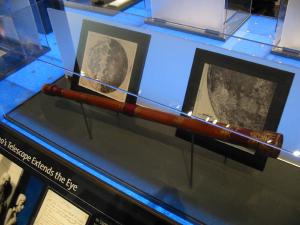Post
Raising a Glass
27 October 2013
 Michael Dunn
Michael DunnGlass has the useful feature of being transparent at optical wavelengths. That, and the fact that light can refract (change direction) when it passes through curved glass is what made it useful as lenses, and eventually telescopes.
We usually think of Galileo as the inventor of the telescope, but this isn’t the case. Glass lenses have existed in Europe since the 1200s, and by the mid 1300s basic eyeglasses had appeared. These early lenses were pretty basic convex lenses. Convex means that they were thicker in the middle than at the edges, and as a result light passing through them would refract closer together. A magnifying class is a good example of a convex lens, and if you’ve ever let sunlight pass through one to make a concentrated point of light that can set things on fire (kids, don’t try this at home), then you’ve seen its effect.
In the mid 1400s a different type of lens known as a concave lens appeared. These are thicker on their edge than in their middle, and causes light passing through it to spread apart. If you are nearsighted and wear glasses, these are the type of lenses they use.
The first astronomer to use lenses seems to have been Leonard Digges. In the 1570 book Pantometria his son Thomas describes a “proportional glass” that might have been a telescope, though the description is vague. The first true telescope dates to at least 1608, when Hans Lipperhey applied for a patent for the device in the Netherlands. The device used a larger convex lens and a smaller concave lens place along either end of a tube. Light passing through the convex lens would be focused together, and would then pass through the concave lens, which spread the light into its original orientation. The net effect was to magnify the image entering the device.
In July of 1609 Thomas Harriot used such a telescope to look at the Moon. His telescope only had a magnification of 3, which isn’t much at all, so Harriot wasn’t able to determine the nature of the lunar features. That same year Galileo had a similar telescope constructed. Galileo’s first telescope had a magnification of about 9, which was powerful enough to distinguish features of the moon. Galileo’s later telescopes had magnifications of up to 30. So it is Galileo whom we now associate with the telescope.
Refracting telescopes such as Galileo’s are still used today, though they are less popular than reflecting telescopes which are easier to construct at larger sizes. But even reflecting telescopes require an eyepiece, which is typically a glass lens. So even when we aim a mirror to the night sky, we still raise a glass.